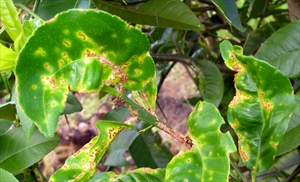Common citrus scab
Pacific Pests, Pathogens, Weeds & Pesticides - Online edition
Pacific Pests, Pathogens, Weeds & Pesticides
Citrus scab (048)
Elsinoë fawcettii. The fungus has an asexual stage, Sphaceloma fawcettii; this is the stage that occurs throughout the Pacific. There are several strains of Sphaceloma fawcettii. Another species, Elsinoë australis is also known, which is more economically important but is less widespread.
Asia, Africa, North, South, and Central America, the Caribbean, Europe, Oceania. It is recorded from American Samoa, Australia, Cook Islands, Fiji, Papua New Guinea, French Polynesia, Guam, Federated States of Micronesia, New Caledonia, New Zealand, Papua New Guinea, Samoa, Solomon Islands, Vanuatu, and Wallis & Futuna.
Elsinoë australia is known from Africa, Asia, North and South America, Europe, Oceania. It is recorded from Australia, Fiji, New Caledonia, Niue, and Samoa.
Lemon, rough lemon and mandarin. Other species of citrus - grapefruit, orange and pomelo - are also susceptible, but less so.
Wart-like, raised light-brown pustules or scabs are produced on leaves, stems and fruit (Photos 1&2). The scabs are grey or pinkish at first, becoming darker as they age. The scabs join together, and their centres become depressed. Old scab lesions have a rough surface, and become cracked and fissured. Leaves become stunted, wrinkled or puckered, with irregular torn margins (Photo 1).
Spores are produced in the scabs, spreading in wind and rain splash. Insects may also spread them. Spread over long distances is on infected nursery plants, and on fruits. The spores need a wetting period of 4 hours for germination and infection.
The leaves, twigs and fruit are infected when they are young, becoming resistant to infection when full size. Fruit is susceptible to infection until about 3 cm diameter.
The fungus distorts the leaves, and causes unsightly infections on the fruit. Infections may reduce market value, but it is unlikely they affect yield. The disease is more serious on seedlings in the nursery, especially on susceptible roots stocks, e.g., sour orange, rough lemon, Rangpur lime, Poncirus trifoliata and Citrus limonia. It may stunt the seedlings, making them difficult to bud.
Overall, scab is a minor disease in mature plantations, unless lemons and other susceptible citrus species are grown commercially. It is more serious as a disease of nurseries.
Look for the raised scabs on leaves, twigs and fruit. On young leaves, the scabs are surrounded by a bright yellow margin. Look for twisted, out-of-shape leaves.
The two species, Elsinoë fawcettii and Elsinoë australia are separated on host species and also by molecular methods. Elsinoë fawcettii affects young foliage and fruit of lemon, mandarin, tangelo, grapefruit; lime and orange are less affected. Elsinoë australia affects sweet orange and mandarin. The scabs of Elsinoë australis are larger, smoother and more circular than the irregular, warty scabs of Elsinoë fawcettii.
.
CULTURAL CONTROL
Before planting:
- Establish nurseries for production of rootstocks and budwood at distance from commercial orchards where the disease may be present.
During growth:
- Prune trees regularly to keep the canopy open and free of deadwood; this is to remove sources of spores and to improve air movement.
CHEMICAL CONTROL
Fungicides should be applied to plants in nurseries at the beginning of leaf flush to prevent infection leading to stunted bushy plants that are difficult to bud. Copper (copper oxychloride) or chlorothalonil are suitable choices.
Treating mature lemon trees is not recommended. They produce multiple crops, meaning that fruit develops throughout the year and several spray treatments would be required, especially in the high rainfall of most Pacific island countries. Such treatments are unlikely to be economic.
____________________
When using a pesticide, always wear protective clothing and follow the instructions on the product label, such as dosage, timing of application, and pre-harvest interval. Recommendations will vary with the crop and system of cultivation. Expert advice on the most appropriate pesticides to use should always be sought from local agricultural authorities.
AUTHORS Helen Tsatsia & Grahame Jackson
Information from Ferrin D (2010) Citrus Scab (Elsinoë fawcettii) and Sweet orange scab (Elsinoë australis). Louisiana Plant Pathology. Disease Identification and Management Series. LSU AgCenter. (https://www.lsuagcenter.com/NR/rdonlyres/E9FEE4CD-CED2-4807-98D3-1F8FF8F0AF5F/74234/pub3169CitrusScabsHIGHRES.pdf); and Hardy S, Donovan N (2007) Managing lemon scab in citrus. Primefact 750. NSW, DPI, Australia. (https://www.dpi.nsw.gov.au/__data/assets/pdf_file/0020/138242/managing-lemon-scab-in-citrus.pdf); and CABI (2019) Elsinoë fawcettii (citrus scab) and CABI (2020) Elsinoë australis (citrus scab). Crop Protection Compendium. (https://www.cabi.org/cpc/datasheet/20777 and https://www.cabi.org/cpc/datasheet/20774); and from Citrus diseases, Citrus scab. USDA, University of Florida. (https://idtools.org/id/citrus/diseases/factsheet.php?name=Citrus%20scab).
Produced with support from the Australian Centre for International Agricultural Research under project PC/2010/090: Strengthening integrated crop management research in the Pacific Islands in support of sustainable intensification of high-value crop production, implemented by the University of Queensland and the Secretariat of the Pacific Community.





